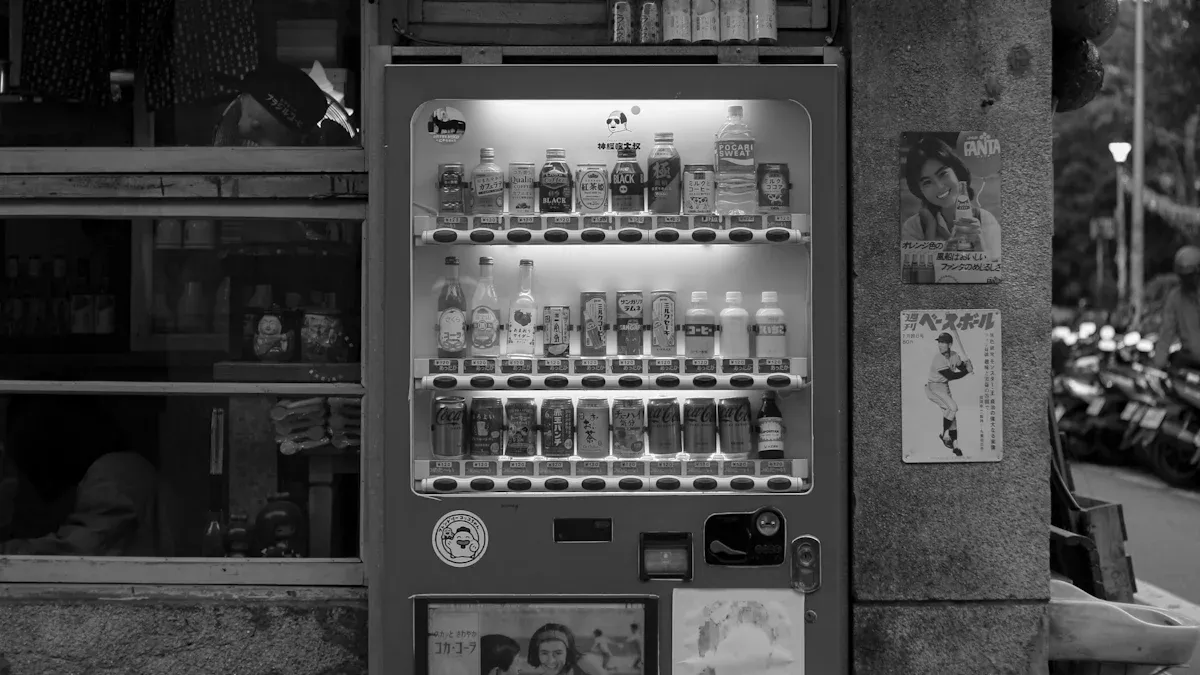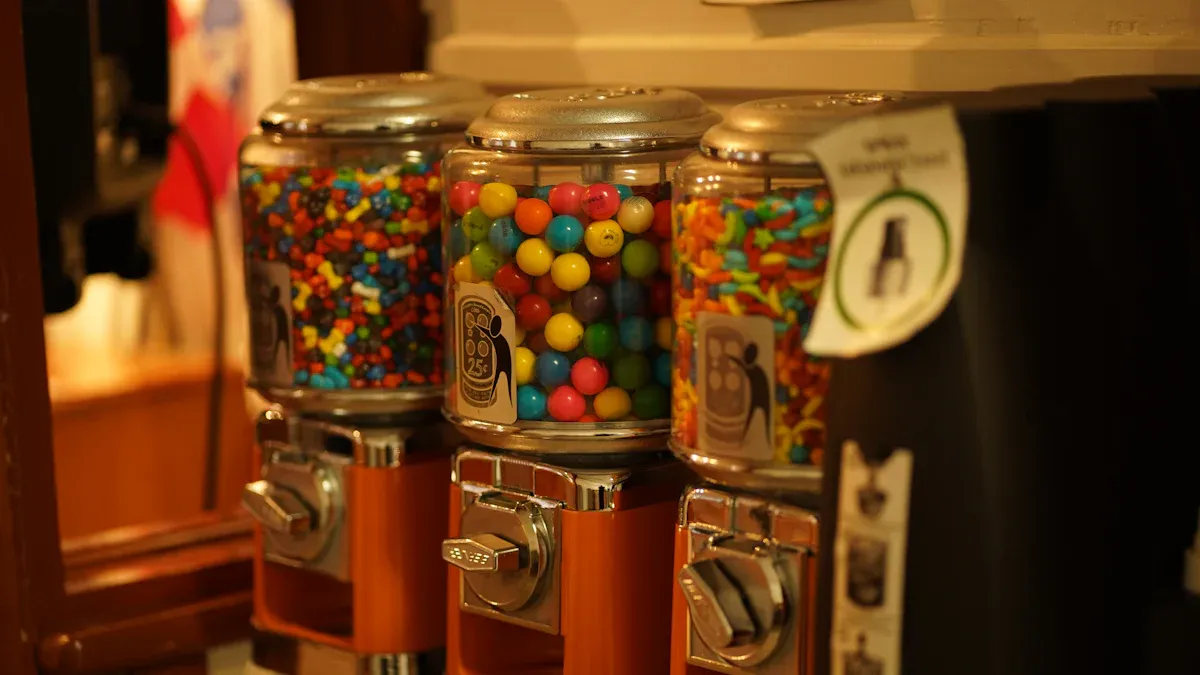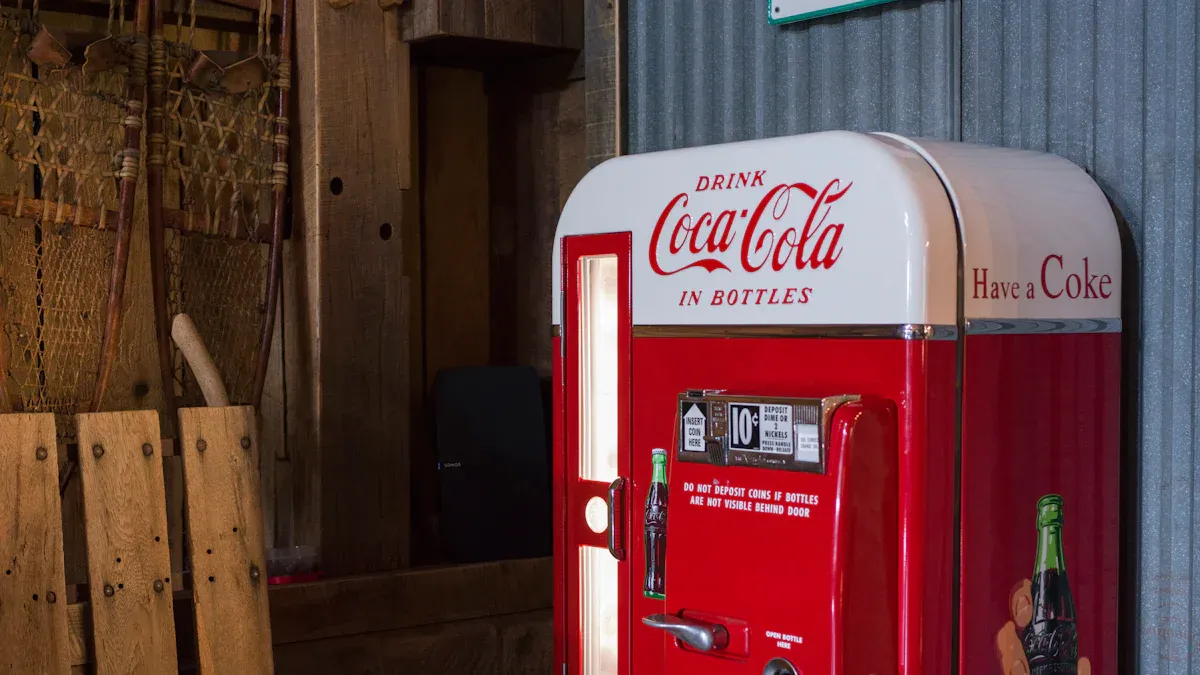Vintage Snack Vending Machines

Vintage Snack Vending Machines bring memories of old diners, movie theaters, and bustling arcades. Collectors often seek these machines because they love the bright colors, chrome accents, and classic coin slots. Many people use them as unique pieces in homes or shops. These machines show the fun style of past decades and often spark conversations. Nostalgia and history make them popular with both new and experienced collectors.
Key Takeaways
Vintage snack vending machines are at least 20 to 30 years old and often have rare features or original parts that increase their value.
These machines stand out with bright colors, chrome accents, glass fronts, and manual coin mechanisms that bring a nostalgic feel.
Collectors enjoy finding different types like snack and drink machines, candy and gumball machines, and specialty machines with unique designs.
Restoring and maintaining vintage machines can boost their value and keep them working smoothly for display or use.
You can find vintage vending machines online, at auctions, or antique markets, and proper care helps preserve their charm and function.
What Is Vintage?
Age and Rarity
Collectors often use the word "vintage" to describe snack vending machines that are at least 20 to 30 years old. Most experts agree that machines made before the 1980s fit this label. Age alone does not make a machine vintage. Rarity also plays a big role. Some machines became rare because companies made only a few of them or stopped making them after a short time. Machines from famous brands like Coca-Cola or Pepsi often attract more attention.
Tip: Machines with original paint, logos, or parts usually have higher value. Collectors look for these details when searching for rare finds.
A few factors can make a machine rare:
Limited production runs
Unique features or designs
Special editions for events or holidays
Surviving in good condition over many years
A rare machine often becomes a centerpiece in a collection. People enjoy finding models that few others own.
Design Features
Vintage snack vending machines stand out because of their unique designs. Many have bright colors, chrome trim, and glass fronts that let users see the snacks inside. Some machines use manual levers or knobs instead of electronic buttons. Others feature coin mechanisms that make a satisfying "clunk" when used.
Feature | Description |
|---|---|
Glass Fronts | Show snacks or candy inside |
Chrome Accents | Add shine and style |
Manual Operation | Use levers, knobs, or cranks |
Coin Mechanisms | Accept old coins, often with sounds |
Designers in the past wanted machines to look fun and inviting. These features help people remember the excitement of buying a treat from a vending machine. Today, collectors value these design elements because they show the style and technology of earlier times.
History and Evolution
Early Machines
The story of snack vending machines began with simple, mechanical devices. Early models appeared in the late 19th and early 20th centuries. These machines often sold gum, peanuts, or candy. Operators used coin mechanisms to control access. Companies like Exhibit and Bally Manufacturing played important roles. Bally entered the market in 1956 with a hot and cold drink machine. This period saw new ideas, such as the Mold-A-Rama machine in the late 1950s. Mold-A-Rama used injection molding to create small plastic toys on demand. World War II also influenced the industry. The war increased demand for convenient snacks and drinks, which helped vending machines become more popular.
Technological Changes
Over time, snack vending machines changed a lot. Early machines used only mechanical parts. Later, inventors added new features to improve performance and reliability. The table below shows some key innovations and their impact:
Innovation | Timeline | Operational Impact |
|---|---|---|
1930s (1937) | Allowed storage of cold drinks and perishable snacks. | |
Incorporation of Heating Elements | 1960s-1970s | Enabled vending of hot foods like burgers and pizza. |
Addition of Electronic Components | 1970s | Improved reliability with digital timers and automated change dispensers. |
Expansion of Product Offerings | Added fresh food and healthier snacks to the selection. | |
Cashless Payment Systems | 1990s | Allowed use of cards, making transactions faster and easier. |
2000s | Enabled remote monitoring, restocking, and personalized experiences. |
Modern retro models now use smart technology. Operators can track inventory and restock machines more efficiently. Cashless payments, such as credit cards and mobile wallets, have made buying snacks easier for everyone.
Cultural Impact
Vintage Snack Vending Machines have become symbols of American pop culture. People remember them from diners, movie theaters, and arcades. These machines often appear in movies and TV shows. They remind people of simpler times and shared experiences. Collectors value them for their design and history. Trade associations and legal changes also shaped the industry. The rise and fall of companies like Bally and Exhibit show how the market changed over time. Today, these machines connect generations and inspire nostalgia.
Types of Vintage Snack Vending Machines

Snack and Drink Machines
Snack and drink machines make up the largest group of Vintage Snack Vending Machines. These machines often appear in schools, offices, and train stations. They usually offer chips, candy bars, cookies, and cold drinks like soda or juice. Many collectors prefer these models because they remember using them as children. According to a 2020 IBISWorld report, 72.4% of vending machines are "full-line" models that mainly dispense snacks and beverages. This number shows that most collectors and operators choose snack and drink machines over other types. The popularity of these machines has lasted for decades.
Collectors often look for machines from famous brands such as Coca-Cola, Pepsi, and Dr Pepper. Some machines have glass fronts that show the snacks inside. Others use manual levers or push buttons to release the product. Many models feature coin mechanisms that make a loud sound when someone inserts a coin. Some machines combine snacks and drinks in one unit, which makes them even more interesting for collectors.
Note: Machines with original logos and working coin slots often have higher value.
Candy and Gumball Machines
Candy and gumball machines have a special place in the world of Vintage Snack Vending Machines. These machines often stand on a single pole or sit on a counter. Children love turning the crank and watching a gumball roll down the chute. Many candy machines use bright colors and clear glass globes to attract attention. Some models offer peanuts, jawbreakers, or small toys along with gum.
Collectors enjoy finding rare designs, such as machines shaped like cartoon characters or animals. Some machines use unique coin mechanisms that only accept certain coins. Others have special features, like spinning wheels or flashing lights. Candy and gumball machines often appear in diners, arcades, and grocery stores. Their simple design and fun operation make them popular with both new and experienced collectors.
Machine Type | Common Features | Popular Locations |
|---|---|---|
Gumball Machine | Glass globe, crank handle | Arcades, diners |
Candy Machine | Coin slot, small chute | Grocery stores, shops |
Specialty Machines
Specialty machines include models that do not fit into the usual snack or candy categories. These machines often serve unique products, such as coffee, ice cream, or peanuts. Some specialty machines even act as slot machines, offering a chance to win a prize. Coffee vending machines became popular in the 1960s and 1970s. They often use manual levers and offer different drink choices. Ice cream machines keep treats cold and use special mechanisms to deliver the product.
Peanut machines often use glass fronts and metal scoops. Some models allow users to watch the peanuts drop into a cup. Slot machines combine vending with games of chance. These machines often have bright lights and spinning reels. Collectors value specialty machines for their unusual designs and rare features.
Tip: Specialty machines often become the highlight of a collection because of their unique look and operation.
Vintage Snack Vending Machines come in many shapes and sizes. Each type offers its own charm and history. Collectors enjoy searching for rare models and learning about the different features that make each machine special.
Collecting Vintage Snack Vending Machines
Why Collect?
People collect Vintage Snack Vending Machines for many reasons. Nostalgia plays a big part. These machines remind collectors of childhood memories and special places. The bright colors and unique designs add charm to any room. Some collectors enjoy the hunt for rare models. Machines with original parts or special features often become valuable over time. Many collectors see these machines as investments. The value of a rare or well-kept machine can increase, especially if it comes from a famous brand.
Collectors often say that each machine tells a story from the past.
Where to Find
Collectors can find Vintage Snack Vending Machines in several places. Online marketplaces like eBay and Amazon offer a wide range of machines. Buyers can compare prices and find both common and rare models. Auctions, both online and in person, give buyers a chance to get machines at lower prices, but buyers must check the condition carefully. Specialized vending machine websites and distributors sometimes list refurbished or vintage models with detailed information. Collector websites, antique markets, and specialized auctions often have machines meant for display. Local classifieds and business-for-sale platforms also list machines, but these may cost more or come without warranties.
eBay and Amazon: Wide selection, many price points
Auctions: Competitive prices, but "as-is" sales
Specialized websites: Refurbished options, detailed specs
Antique markets: Unique finds, often for decor
Local classifieds: Possible deals, but higher risks
Evaluating Condition
Evaluating the condition of a machine is important before buying. Collectors look for original paint, working coin mechanisms, and intact glass fronts. Machines with missing parts or heavy rust may need repairs. Checking for original logos and serial numbers helps confirm authenticity. Some sellers provide detailed photos and descriptions. Buyers should ask questions about the machine's history and any repairs. A table can help collectors remember what to check:
Feature | What to Look For |
|---|---|
Paint/Logos | Original, not repainted |
Coin Mechanism | Working, not replaced |
Glass Front | No cracks or major scratches |
Serial Numbers | Match brand and model |
Collectors who follow these steps can find machines that hold value and bring joy for years.
Restoration and Display

Restoration
Restoring Vintage Snack Vending Machines has become popular among collectors. Many choose to bring old machines back to life because restoration can increase both value and enjoyment. Experts often follow detailed steps, such as the 101-point restoration process used for machines like the Vendo 39 Coca-Cola model. This process checks every part, from coin mechanisms to paint. Restorers keep original signage, paint, and even the natural patina. Some machines receive a special certification, such as the H.J. Nick Brass Tag, which proves authenticity and quality. Collectors trust these certifications because they show the machine works as it did when new. Restored machines often become safer and more valuable investments.
Restored machines with original features and certifications attract more interest from collectors and insurers.
Display Ideas
Collectors enjoy showing off their Vintage Snack Vending Machines in creative ways. Many place machines in game rooms, home theaters, or kitchens. Some use them as statement pieces in shops or offices. Machines with bright colors or glass fronts look great against plain walls. Others group several machines together for a retro display. Adding snacks or drinks inside makes the display more fun and interactive. Some people use small shelves or lights to highlight special features.
Popular display locations:
Game rooms
Home bars
Living rooms
Retail stores
Maintenance
Proper care keeps Vintage Snack Vending Machines looking and working their best. Owners should clean glass and metal parts with gentle cleaners. Regularly checking coin mechanisms helps prevent jams. Lubricating moving parts keeps levers and cranks smooth. Owners should avoid harsh chemicals that can damage paint or logos. Covering machines when not in use protects them from dust and sunlight. Keeping machines dry helps prevent rust and wear.
Maintenance Task | How Often | Purpose |
|---|---|---|
Clean glass/metal | Monthly | Keep appearance bright |
Check coin mechanism | Every 3 months | Prevent jams |
Lubricate parts | Twice a year | Ensure smooth operation |
Inspect for rust | Every 6 months | Stop damage early |
Regular maintenance helps preserve both the function and value of these classic machines.
Vintage Snack Vending Machines continue to capture attention with their bright designs and unique features. Many collectors enjoy finding, restoring, and displaying these machines. They add character to homes and shops. Anyone interested in history or design can start a collection.
Explore local shops or online markets.
Try restoring a machine for fun.
Share your favorite finds or stories in the comments. Every collection begins with one special machine.
FAQ
How can someone tell if a vending machine is truly vintage?
Collectors check the age, brand, and design. Machines made before the 1980s often count as vintage. Original paint, logos, and coin mechanisms help prove authenticity. Serial numbers and manufacturer labels also give clues.
Are vintage snack vending machines safe to use?
Most vintage machines are safe if restored and maintained. Owners should check for electrical issues, sharp edges, or rust. Experts recommend professional inspection before using them for food or drinks.
What snacks did old vending machines usually sell?
Older machines often sold gum, peanuts, candy bars, and soda. Some models offered chips, cookies, or small toys. The selection depended on the machine’s type and location.
Can people still find parts for vintage vending machines?
Yes, many parts are available online or through specialty shops. Collectors often find replacement coin mechanisms, glass panels, and decals. Some companies even make reproduction parts for popular models.
Do vintage vending machines increase in value?
Well-kept machines from famous brands often gain value over time. Rarity, original features, and working condition affect price. Collectors sometimes see restored machines sell for much more than their original cost.
See Also
Unique Collectible Items Found In Vending Machines
How Vending Machines Transformed From Snacks To Smart Devices
Edible Vending Machines Changing The Way Snacks Are Accessed
Exploring Antique Vending Machines History From Holy Water To Soda
Space Efficient Tabletop Snack Vending Machines For Modern Areas
